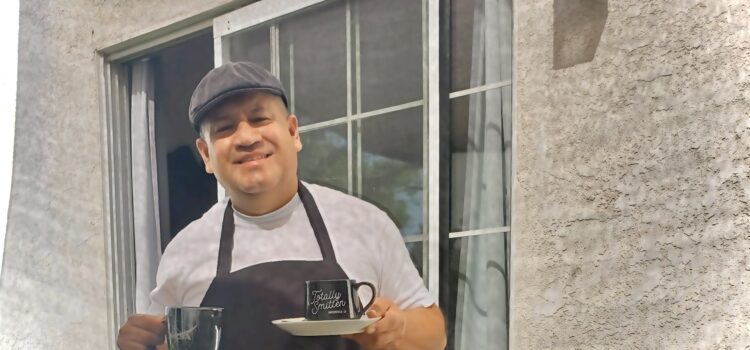
The days may start a few hours later than normal, but for teachers in the Bakersfield City School District work continues without recess.
No school bells, roll call, rallies, or flag raising ceremonies but a lot of adapting to virtual teaching methods required during a global pandemic. Not familiar with Zoom or Google Classroom? You will be, mark my words.
For Bonifacio Caballero, 4th grade teacher at College Heights Elementary, his regular 6 a.m. morning ritual of coffee and breakfast with NPR on the Bluetooth speaker is a part of daily life as an educator. Keeping a close eye on the time, he checks his work appearance before packing his lunch and setting off on his eight-minute commute to the school. Seven days a week unless it’s a holiday or summer break.
“Mornings are like meditation time for me. If I can get an extra 30-minutes to prep and decompress right before the bell rings, I’m good for the day,” said Caballero during a recent afternoon call from his quiet home office. “But a lot of times the kids will show up earlier than I do and want to come in the class and hangout before the bells rings.”
Preparing for a daily walk in the warm sun with his dog, Caballero admits the sudden restructuring of life has made recalling the chaotic scenes before class bittersweet reminders of the commitment he’s made to his students.
“I miss the kids. Once the bells rings, I’d either have to kick some out or get my students ready to go,” he said. “I apologize to them if I’m not having a good day. ‘I owe you one,’ I’d say. Some kids would be surprised to hear a teacher apologize, but then remind me, ‘Ok, you owe me one.’
Caballero’s class of 31 students have been on his mind everyday since he and the rest of his colleagues were given the notice to get the kids packing in preparation of the COVID-19 quarantine last month.
“It had already started setting in my mind a week before the order that we have to leave as if we’re evacuating for a disaster immediately,” Caballero said recalling how he also scrambled to ensure his students had enough school supplies in their possession before leaving.
“I made them take all of their pencils home. If they needed extras, I gave them what we had. Highlighters, pens, pencils, it’s all replaceable,” he said. “Some kids don’t even have one pencil at home.”
Anticipating a return to regular in-class instruction sometime in May, Caballero says the subsequent closures for the remainder of the school year came as no surprise.
“I thought we were a little late in closing the schools. I just kept thinking, how am I going to keep these kids engaged?”
Caballero drew upon his own skills as an artist to develop an at-home plan that would both engage students while creating an outlet to express themselves during the quarantine, by incorporating Zoom web conferencing, Google Classroom, and ClassDojo. With required guidance from the school district on what would be accepted as part of the school’s curriculum, Caballero went to work on a series of step-by-step drawing art projects for his students.
“I had some art supplies that I felt would be more crucial than a math book right now. I usually put the project on one sheet. I upload it to an editable PDF, then the district decides if it’s okay.”
In addition to art, Caballero says assignments follow a mix of the “Three Rs”: reading, writing, and arithmetic – and physical education.
“My writing assignments are for the kids to tell me about their experiences in a journal. You can tell me if you miss your friends. One day they’re going to look back on this moment in history.”
Teachers like Caballero and others are assigning the work as required, but it’s another to get kids (even parents) to even acknowledge the work as they straddle two worlds for an education.
“We’ve been giving them work packets to do at home, but the ones that really need it just aren’t doing it because many parents just don’t bother picking them up at the school. Kids today are computer babies, so my Google classroom is essential. Teachers have to be really tech savvy to keep up.”
Good lines of communication are another reason to stay tech savvy says Caballero as many of his students come from low-income homes with limited access to the internet. To ensure his students have a way to ask a question or say hello, Caballero has added a separate phone available for parents and students to call during regularly scheduled school hours.
“I have a set number of hours for student tutoring and office hours to be available. When the time is up, I don’t answer; however, if they need help, I’m gonna be here for them.”
Once the official work day is over and the phone is set on the charger, Caballero says he enjoys cooking among other hobbies.
“I don’t stay idle for long. I’ve started a lot of woodworking, electrical, and cooking projects – experimenting with making corn tortillas, which like making bread is easy to do, but it takes years to master. Flour tortillas are next.”
And what is a kitchen without his favorite music?
“I love classic jazz, boleros. I also listen to a lot of early ranchera music, but the kind before Vicente Fernandez. That will upset a lot of people, but that’s okay.”
Kern Sol News is a youth-led journalism organization in Kern County. In their stories, reporters shine light on health and racial disparities in under-served communities across Kern. For more stories by South Kern Sol, head to southkernsol.org.